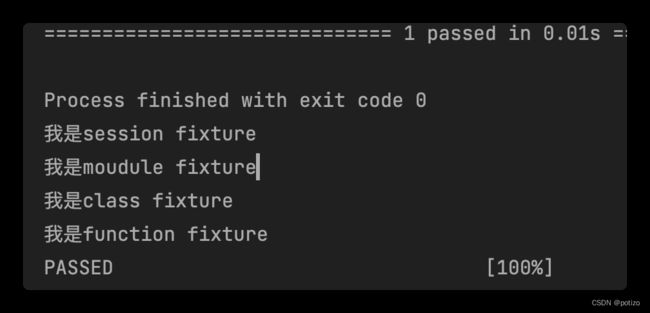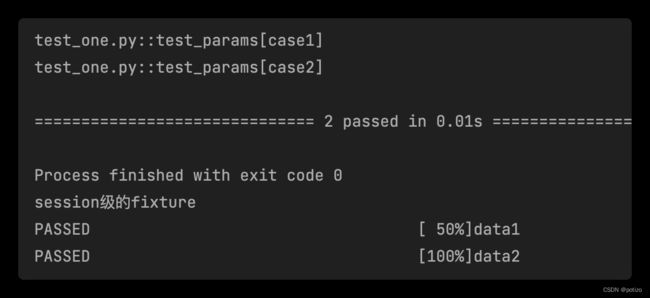pytest之fixture用法
一、fixture是什么
fixture是pytest用于将测试前后进行预备、清理工作的代码处理机制。
相较于setup和teardown而言,有以下几点优势:
- fixture命名更加灵活,局限性较小
- conftest.py配置里面可以实现数据共享,不需要import就能自动找到一些配置
二、fixture的scope
- (scope=“function”) 每一个函数或方法都会调用,默认就是function
# 示例:1、先定义一个fixture。这个fixture的函数不需要test_开头命名
@pytest.fixture(scope='function')
def t_func1():
print('function级别的前置操作:func1')
# 2、在用例里调用这个fixture
def test_one(t_func1):
expect = 1
actual = 1
assert expect == actual
- (scope=“class”) 每一个类调用一次
# 示例:1、先定义一个fixture。这个fixture的函数不需要test_开头命名
@pytest.fixture(scope='class',autouse=True)
def t_func2():
print('class级别的前置操作:func2')
# 2、在用例里调用这个fixture
class TestClassFixture():
def test_one(self):
expect = 1
actual = 1
print('ok')
assert expect == actual
def test_two(self):
expect = 1
actual = 2
assert expect == actual
虽然类中有2个方法,但fixture的scope是class,因此只执行一次。

- (scope=“module”) 每一个.py文件调用一次
# 示例:1、先定义一个fixture。scope为module
@pytest.fixture(scope='module',autouse=True)
def t_module():
print('module级别的前置操作')
#2、py文件中定义一个class一个函数
class TestClassFixture():
def test_one(self):
expect = 1
actual = 1
print('ok')
assert expect == actual
def test_two(self):
expect = 1
actual = 2
assert expect == actual
def test_three():
expect = 1
actual = 2
assert expect != actual
可以看到,虽然.py文件下存在一个类和一个函数。但只执行了一次前置操作 4. (scope=“session”) 是多个文件调用一次
4. (scope=“session”) 是多个文件调用一次
#1、在conftest.py中定义fixture
@pytest.fixture(scope='session',autouse=True)
def t_session():
print('session级的fixture')
#2、同一个文件夹,创建2个.py文件
#3、terminal中执行pytest命令
可以看到,test_fixture这个文件下,虽然有test_one和test_two两个py文件,但只执行了一次前置操作。

- fixture的作用范围(执行顺序):session>module>class>function
@pytest.fixture(scope="function")
def t_function():
print("我是function fixture")
@pytest.fixture(scope="class")
def t_class():
print("我是class fixture")
@pytest.fixture(scope="module")
def t_moudule():
print("我是moudule fixture")
@pytest.fixture(scope="session")
def t_session():
print("我是session fixture")
class TestOrder:
def test_order(self,t_function,t_session,t_moudule,t_class):
assert 1==1
虽然打乱了顺序,但是执行顺序依然是session>module>class>function

三、使用conftest管理fixture
- conftest.py为固定写法,不可修改名字。使用conftest.py文件方法无需导入
- 函数作用于当前文件夹及下属文件,conftest可以放在上层目录,但是要注释掉当前目录的方法,如果方法都一样的话
四、fixture返回数据,解决接口参数依赖
#1、conftest.py文件中定义fixture
@pytest.fixture(scope="function")
def get_params():
params = {'key1': 'value1', 'key2': 'value2'}
return params
#2、用例文件中,使用fixture得到参数
import pytest
import requests
def test_getparam(get_params):
print("测试get请求")
#第1种方法
r=requests.get('https://httpbin.org/get',params=get_params)
#第2种方法
key1 = get_params['key1']
key2 = get_params['key2']
r=requests.get('https://httpbin.org/get',params={'key1':key1, 'key2':key2})
print(r.status_code)
assert r.status_code == 200
res = r.json()
assert res['url'] == 'https://httpbin.org/get?key1=value1&key2=value2'
assert res['origin'] == '163.125.202.248'
assert res['args']['key1'] == 'value1'
assert res['args']['key2'] == 'value2'
五、yield做后置操作
#1、conftest文件定义fixture,yield关键字之后可以定义后置操作
@pytest.fixture(scope='function')
def t_func1():
print('function级别的前置操作:func1')
yield
print('function级别的后置操作:func1')
# 2、用例文件
def test_three(t_func1):
expect = 1
actual = 2
assert expect != actual
print('ok')
#1、conftest文件定义fixture,yield也可以返回值,但pytest中不常用这个用法
@pytest.fixture(scope='function')
def t_func1():
print('function级别的前置操作:func1')
yield 'potizo'
print('function级别的后置操作:func1')
# 2、用例文件
def test_three(t_func1):
expect = 1
actual = 2
assert expect != actual
print('ok')
print(t_func1)
六、fixture的另一种调用方式:uesfixtures
@pytest.fixture(scope='function',autouse=True)
def get_params():
params = {
'key':'value'
}
return params
- fixture的调用方式有2种,usefixtures这种无法接受返回值。
-
第一种,可以接收返回值:
def test_func(get_params):
xxx -
第二种,无法接收返回值:
@pytest.mark.usefixtures(‘get_params’)
def test_func():
xxx
- usefixtures的执行顺序
#1、conftest文件中定义2个fixture
@pytest.fixture(scope='function')
def t_func1():
print('function级别的前置操作:func1')
yield 'potizo'
print('function级别的后置操作:func1')
@pytest.fixture(scope='function')
def t_func1_new():
print('function级别的前置操作:func1_new')
yield 'potizo'
print('function级别的后置操作:func1_new')
#2、用例文件中使用usefixtures方式调用这两个fixture
@pytest.mark.usefixtures("t_func1")
@pytest.mark.usefixtures("t_func1_new")
def test_usefixtures():
print('ok')
执行顺序:靠近方法的那个fixture先调用

也可以在usefixtures中一次调用多个fixture,用,分割。
@pytest.mark.usefixtures("t_func1","t_func1_new")
def test_usefixtures():
print('ok')```
七、fixture的2个参数:ids和params
# 1、 定义fixture
#request和params\ids是关键字,不能改
@pytest.fixture(params=["data1","data2"],ids=["case1","case2"])
def params_fixture(request):
return request.param
#2、 测试方法调用这个fixture
def test_params(params_fixture):
print(params_fixture)




